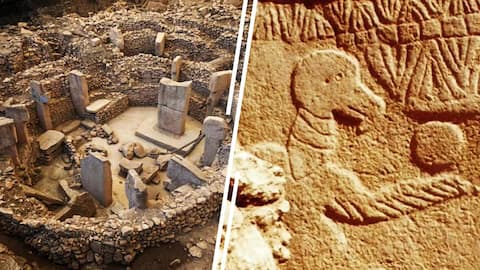Ancient solar calendar unearthed in Turkey
What's the story
The archaeological site of Gobekli Tepe in Sanliurfa, Turkey may be home to the world's oldest solar calendar.
This discovery was led by Martin Sweatman, a scientist at the University of Edinburgh.
The findings were published last month in Time and Mind journal.
Gobekli Tepe is known as the world's first sanctuary and overlooks the plateau of ancient Mesopotamia.
Symbols
Gobekli Tepe: A sanctuary of ancient symbols
The site features pillars adorned with V-shaped symbols and animal shapes, which Sweatman suggests depict the cycles of the sun and moon.
These markings could indicate two significant findings: the pillar may be the world's oldest lunisolar calendar, and it might serve as a memorial to a comet strike that occurred approximately 13,000 years ago.
Sweatman suggested that the inhabitants of Gobekli Tepe were likely attentive to the movements of the sky.
Interpretation
Comet strike memorial and dawn of civilization
Sweatman believes each V-shaped symbol represents a single day, collectively recording the date a swarm of comet fragments hit Earth in 10,850 BC.
This event triggered a 1,200-year ice age leading to the extinction of many large animals.
Sweatman suggests this event might have sparked civilization by initiating a new religion and prompting agricultural developments.
He proposed that their efforts to document what they observed might represent the initial stages leading to the development of writing thousands of years later.
Skepticism
Controversy surrounds interpretation of ancient symbols
The potential comet strike has intrigued and divided scientists for years.
If Sweatman's V-symbol hypothesis proves accurate, it could offer groundbreaking evidence for this theory.
However, Jens Notroff, an archaeologist who commented on the excavators' website, expressed skepticism about the symbolic meanings of the markings.
He noted that there is often an obsession with finding a secret or hidden code that needs decoding, whereas the reality is simply about past humans living their lives.
Confidence
Sweatman's confidence in his findings
Despite skepticism, Sweatman remains confident that his recent discovery aligns with his earlier research.
He expressed strong confidence that it indeed represents a date.
His research suggests ancient people were capable of recording their observations of the sun, moon, and constellations using a solar calendar to keep track of time and mark seasonal changes.
This breakthrough came from an emailed tip suggesting the V-shaped symbols could represent the lunar cycle.
Decoding
Decoding the V-Symbols: A leap in understanding
According to Sweatman's findings, each V-shaped symbol could signify a single day.
Sweatman's research states that this interpretation enabled researchers to identify a 365-day solar calendar on one of the pillars, comprising 12 lunar months plus 11 additional days.
The final V on the pillar is represented by a V worn around the neck of a birdlike beast thought to represent the summer solstice constellation at that time.
Significance
Ancient astronomical observations: A glimpse into the past
While understanding the exact mindset of ancient humans may remain elusive, these findings offer clues about the significance they placed on astronomical events.
Sweatman emphasized that this event was of great importance to the people of that era, as indicated by their detailed and deliberate carvings.
The discovery at Gobekli Tepe provides a unique insight into how our ancestors observed and recorded celestial events.
